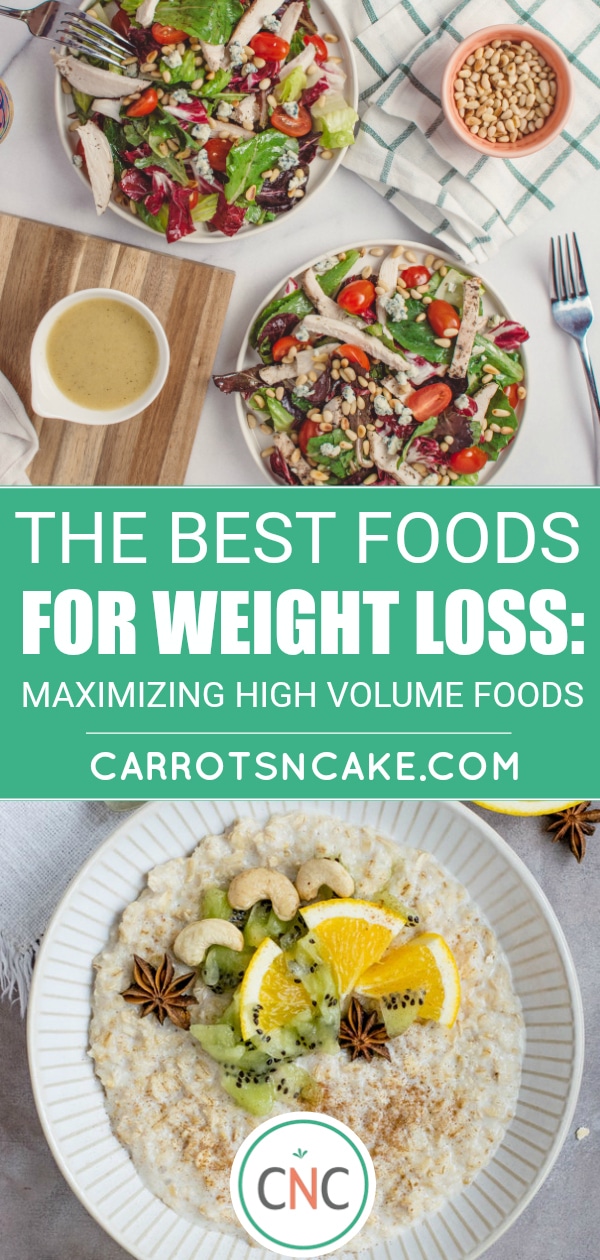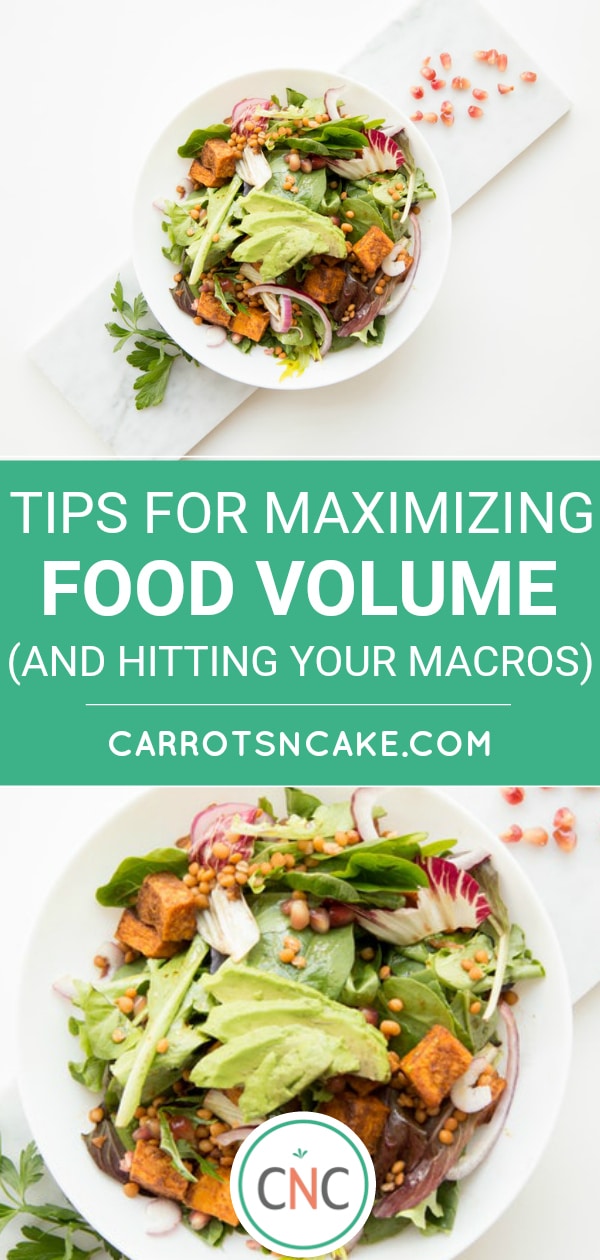The Best Foods for Weight Loss: Maximizing High Volume Foods
If you know me, you know that I’m not much of a light snacker. I’ll rarely grab a bag of chips or a granola bar by itself to hold me over. I like to feel FULL after I’ve eaten, so what I really prefer are “mini meals” as opposed to true snacks. A lot of the time, I will actually snack on small portion of leftovers from lunch or dinner in order to get a balanced ratio of macros. To me, there’s nothing worse than eating only to feel hungry just an hour or two later.
Bottom line?
I like to eat, and I don’t do small portions, which is entirely opposite of what we’re conditioned to believe is the “best” way to lose weight. I mean, 100 calorie snacks? No, thank you! Diet culture promotes that the feelings of fullness and satiety are a “bad” thing – and in order to maintain a calorie deficit and see progress, we should learn to live with a constant feeling of hunger. What a recipe for disaster! You can’t find a healthy and sustainable way of eating if you’re starving all the time!
While, yes, you do technically need to eat in a calorie deficit to lose body fat, that doesn’t necessarily mean you need to eat LESS – notice I said calorie deficit, not food deficit. If you strategize your diet correctly and learn to make the most of your macros/calories, you can lose weight and maintain it while nourishing your body and feeling satisfied and content after each meal. What’s the trick? Enter high volume foods!

Many of you guys have likely heard the term “high volume” thrown around and may have even seen examples of volume-based meals. But what exactly are high volume foods? Put simply, a high volume food is one in which the amount of food outweighs the caloric density. Typically, the more fiber, water, and/or air a food contains, the higher its volume is in relation to its calories. Let’s break it down using cauliflower rice and white rice as an example.
If we’re comparing both foods (apples-to-apples), one cup of cauliflower rice contains about 25 calories and 5 grams of carbs while one cup of white rice contains about 220 calories and 46 grams of carbs. Both foods fit the same portion size, but if you’re maintaining a deficit, you would get way more bang for your buck if you subbed in cauliflower rice from time to time. You’re technically eating the same amount of food, but for fewer calories (and carbs) overall. In fact, you could eat double and even triple the amount of cauli rice for less than one serving of white rice – and get a bigger dose of nutrients and fiber!

So how can you actively incorporate high volume foods into your diet to really maximize their benefits? Below are some of my favorites and how I fit them into volume-based eating. I hope this gives you guys some ideas and inspiration for your next meal or snack!
Greens – and lots of ‘em!
Basically, if you’re maintaining a deficit and it’s a green veggie, it should have your name all over it! 🙂 Think kale, spinach, arugula, etc. Greens are way more versatile than we give them credit for. Eating as many of them as possible is one of my top tips for adding bulk to meals without adding calories. I love topping a bed of greens with a piece of protein and healthy fats (like grilled chicken and avocado) or sauteeing them with a bit of olive and sea salt for an easy dinner side dish. I will also throw them frozen or fresh into smoothies as a way to add fiber and nutrients. (I swear, you can’t taste them!)
Non-starchy veggies
Most non-starchy veggies are low in calories but HIGH in nutrients, packed with vitamins, minerals, and, of course, fiber and water, which helps to increase the fullness factor while keeping your digestive system happy. Examples include broccoli, Brussel sprouts, zucchini, cucumbers – even beets! My favorite trick is to make sure half my plate is non-starchy veggies to fill me up, especially riced or spiralized veggies! Like the cauliflower rice example above, these carb “alternatives” are awesome when you want something filling and substantial, but also want to keep the meal light on calories. Top them with a protein and a sauce, like lean ground turkey and marinara sauce, for a meal that’s as delicious as traditional pasta, but far more nutritious!
Rice cakes
Rice cakes are the most underrated food, in my opinion! Rice cakes are low in calories, but big on air, so they fill you up quick! Plus, I see them as basically a vehicle to eat other delicious foods. I eat mine topped with nut butter + bananas or fresh berries and mashed avocado + Everything But the Bagel Seasoning. I love these combos for a quick and satiating pre-workout snack when I need to put something in my belly, but don’t want to feel weighed down by a full meal.
Smoothies and soups
Both of these are liquid-based, and anyone who has ever chugged a ton of water knows how full that can make you! And both smoothies and soups are awesome ways to incorporate veggies, especially if you’re not the biggest fan of all the green things! Throw frozen chopped spinach into your smoothie and add a ton of non-starchy veggies to your soup for an easy, tasty way to get an extra hit of nutrition while filling up! I’m loving the frozen, pre-made ones from Daily Harvest right now. Use code carrotsncake to get $25 off your first order!
Fresh fruit
Bring on all the berries, watermelon, and cantaloupe! Strawberries, raspberries, and blackberries have some the highest fiber counts for fruit, while watermelon is chock full of water. When I need a little something sweet after a meal, I try to opt for fresh fruit whenever possible. I’m loving blueberries nuked in the microwave with a scoop of melty nut butter. Mmm!
Oatmeal
When most people think of oats, they think “boring” – but it doesn’t need to be that way! Oatmeal is great for high-volume eating because oats absorb a lot of water, and you can up the protein quotient easily by mixing in egg whites (which actually makes them more voluminous), protein powder, or collagen peptides. You can top the bowl with fruit and nut butter for sweetness and texture, and if you’re feeling really fancy, you can add grated carrots, rice cauliflower (I swear, you can’t taste it) or zucchini for a truly well-balanced and satiating meal that will leave you full for hours! No more mid-morning hangry!
*It’s important to note that just because these foods are less energy-dense, doesn’ mean that they are a free-for-all. You should still measure out portion sizes and track accordingly if you are following a macro-based plan!*
By eating for volume, you’re setting yourself up to eat a lot more food for a lot fewer calories, and in my experience, this is one of the best strategies you can utilize to stay on track for fat loss. We’re literally wired to continue eating if we’re still hungry (as we should be!), but sometimes the reason we are unsatisfied is due to the fact that we’ve eaten a small, calorically high food that has little nutritional value rather than a big, nutrient-dense meal.
I’m all for flexibility in my diet (that’s why I love macros!), but treats should be the exception, not the rule, especially if your goal is fat loss. There’s a big difference between a bowl of potato chips and a bowl of broccoli, and that rings true no matter what way of eating you adhere to. Plus, successfully losing and maintaining weight isn’t just about what we eat or how active we are – our mindset comes into play as well. The way we perceive a full plate of food versus a tiny portion is vastly different. I don’t know about you guys, but when I’m hungry, even just looking at a small portion of food makes me grumpy and unsatisfied!
So there you have it – a quick how-to on maximizing high volume foods for weight loss! By implementing volume-based eating for even a few meals and snacks a day, you will find that sticking to a healthy lifestyle will be far more satisfying, enjoyable, and easier to maintain!
The post The Best Foods for Weight Loss: Maximizing High Volume Foods appeared first on Carrots 'N' Cake.
from Carrots 'N' Cake https://ift.tt/31OiDLd
Comments
Post a Comment